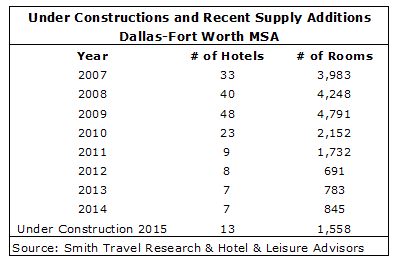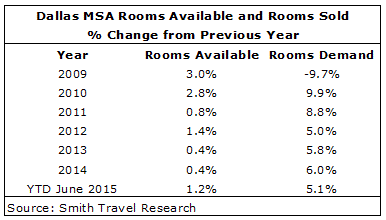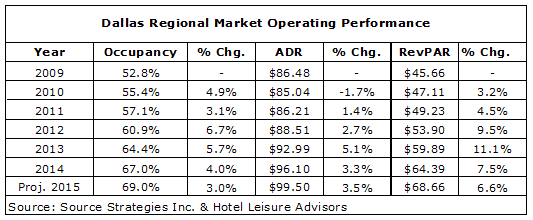The Texas economy had a bumpy start in 2015 due to a sharp drop in global oil prices in late 2014, which resulted in thousands of lost jobs. However, the continued growth of the Dallas-Fort Worth market’s broad and diversified economy is one reason Texas managed to stave off a downturn despite those oil-related job losses. A diversified and growing economy, robust convention market, growing tourism and increasing population have all contributed to the success of the Dallas-Fort Worth hotel market. The hotel market occupancy increased from 52.8% in 2009 to 67% in 2014 and is projected to grow for the foreseeable future.
Robust business climate
In 2013, the Metroplex area led the nation with the largest year-over-year increase in employment and became the fourth-largest employment center in the nation (behind New York City, Los Angeles and Chicago) with more than three million non-farm jobs. Texas’ seasonally adjusted unemployment rate fell to 4.3% in May 2015 (from 5.1% in May 2014) compared to the nation’s 5.5%, which fell from 6.3% over the same time period. Job growth has also been helped as companies relocate to the Metroplex to take advantage of communities that are offering development incentives such as tax increment finance districts, enterprise zones, and job training programs. One such major company is Toyota, which is relocating its U.S. headquarters from California to the Dallas area.
‘Silicon Prairie’ is a nickname associated with Dallas due to the high concentration of semiconductor manufacturing, telecommunications, and other information technology related companies. Texas Instruments, AT&T, HP Enterprise Services, Verizon, Nortel, Ericsson and Alcatel are examples of the large telecom companies that have a presence in the Metroplex.
The Metroplex population stands at 6.9 million, which is 33% higher than in 2000, and is home to 20 Fortune 500 companies, many of which are focused on growing employment sectors like banking, commerce, telecommunications, computer technology, defense, energy, healthcare and medical research, and transportation and logistics. Some of the major corporations headquartered in Dallas include AT&T, American Airlines, JCPenney, Energy Transfer Equity, Southwest Airlines, Tenet Healthcare, Texas Instruments, Dean Foods, and ExxonMobil.
The growth in the national and regional economy has also been positive for the office market. According to the first-quarter 2015 Marketview report by CBRE, the Dallas-Fort Worth office market recorded its 19th consecutive quarter of favorable leasing fundamentals. The Metroplex offers 218.2 million square feet of office space with a total vacancy of 18.3% and average asking lease rate of $20.70 per square feet. In 2014, the market recorded a net absorption of 3.2 million square feet, the most in a single year since 2006.
Tourism growth
Tourism is another major economic driver for the Dallas-Fort Worth area. According to recent research conducted by D.K. Shifflet & Associates for the governor’s Economic Development & Tourism Division, the Dallas-Fort Worth-Arlington metro area received 46.92 million visitors (person-stays) in 2013, up from 44.05 million in 2012. Leisure travelers accounted for 67.4% of the total visitors.
Group demand
There are numerous convention facilities, conference centers, hotels, and community facilities capable of hosting large-scale events in the Metroplex. The Kay Bailey Hutchison Convention Center in downtown Dallas, one of the country’s largest, offers more than one million square feet of exhibit space, with a 9,816-seat arena, a 1,750-seat theater, 96 meeting rooms, and two ballrooms. The Fort Worth Convention Center offers 253,226 total square feet of exhibit space, with a 182,266 square foot exhibit hall, a 28,160 square foot ballroom, and 41 meeting rooms. The Gaylord Texan Resort & Convention Center in Grapevine offers 400,000 square feet of event space and 88 event rooms. The availability of large a convention center gives the Dallas area a competitive edge and allows it to market to larger groups.
Hotel Growth
With its fast-expanding and diversified market, Dallas has been on the radar of hotel owners and investors for years. Since 2007, 175 hotels opened in the Metroplex, with the majority opening during and just after the recession as financing already had been secured. Since then, supply tapered off due to lack of financing. This allowed hotels to ramp up occupancy levels.
Currently there are 13 hotels under construction and many proposals in the market. In addition, hotel sales activity has also picked up due to availability of financing. We have tracked over 15 hotel transactions in 2014 in the Metroplex. Notable sales in the Metroplex included the Four Seasons Resort and Club Dallas ($150 million), Hotel Palomar (price undisclosed), Hyatt Place Plano ($11.5 million) and Sheraton Arlington ($33.6 million).

As a result of the strong economy, the market has recorded increases in occupancy and RevPAR since 2009. As occupancy averages over 70%, we project ADR growth rate will outpace occupancy growth rate starting in 2016. The following table illustrates historical occupancy and average daily rate (ADR) for the Dallas-Fort Worth-Arlington market area.
Outlook
Investment activity and population growth remain strong across the Dallas-Fort Worth market area. The Metroplex population is projected to reach 7.4 million by 2020, an increase of 8.1% between 2015 and 2020. Hotel demand will remain strong throughout the metropolitan area due to its diversified economy, relatively low housing costs, major international airport, and business incentives. However, the depressed price of crude oil and long-term interest rates may cause uncertainty for companies that support the energy industry.
There are many proposals for new hotel developments within various Metroplex communities. As market occupancy levels go above the 70% mark, new hotel developments will be needed to accommodate additional demand. However, developers and investors need to do their due diligence, including conducting a market feasibility study, prior to purchasing land for hotel development.




